![]()
![]()
![]()
Use LEFT and RIGHT arrow keys to navigate between flashcards;
Use UP and DOWN arrow keys to flip the card;
H to show hint;
A reads text to speech;
32 Cards in this Set
- Front
- Back
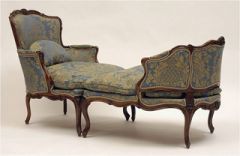
|
Duchesse Brisée (dü-shes brēs-ā)
A two-piece lounging unit consisting of a bergére (an enclosed upholstered French armchair or fauteuil) and a bout-de-pied (foot stool/rest). The chair and separate foot rest were fitted into the contours of the other's seat rails to create one seating unit. The Duchesse Brisée made its appearance in the early 18th century and became a common form of seating during the reign of Louis XV. It is known for being comprised entirely of curved lines with emphasis on the connection between the horizontal and vertical lines. Seen in the picture is a Duchesse Brisée from the mid-18th century during the reign of Louis XV. It is upholstered with a damask textile and carved from solid walnut. |
|
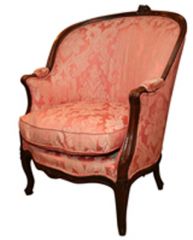
|
Bergere (ber zher')
A low, upholstered French armchair with closed arms, a carved wood frame and legs and a removable seat cushion. The upholstered arms are shorter than the length of the seat. The bergere was first seen in the Louis XV period, when comfort became more important in regards to seat furniture. When first seen, the bergere had many curves and then became more architectural and rectilinear as time progressed. The wood finish could have been painted, lacquered, gilded or waxed. Upholstery was often done in a brilliant color. Cabriole legs were often used on the bergere, as they reached their peak of refinement during this period. |
|
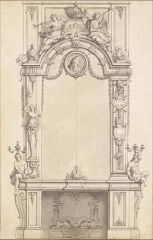
|
Jean Berain I (zhän bë'rān)
Jean Berain I was a French draftsman, designer, painter and engraver and was the artistic force in the Royal office where all the designs originated for court spectacles. Jean Berain I is known as the “elder.” His style was of light arabesques and grotesques and this was an essential element in the style Regence that led to the French Rococo. The engravings of Jean Berain led the way to alterations in the use of the grotesque ornament and in the chimney piece design. He gave greater delicacy to this type of decoration and engravings. He furnished designs for the decorations and costumes used in the opera performances, for court festivals and for public solemnities such as funeral processions and inspired the ornamentation of rooms and of furniture. |
|
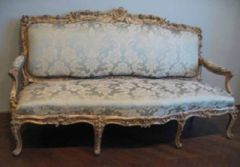
|
canapé (kan'ə pā)
A multiple-seating unit or settee which was generally upholstered and occasionally caned dating from 18th-century France. Originally from the word canopy, the sofa was covered with a canopy but later the canopy was removed but the name still applied to the form of seating. The principle features of design incorporated in the bergère and fauteuil in the different prevailing French styles were essentially found in the canapé for it was generally designed en suite with the chairs. Seating was no longer along the walls but adapted to the needs of conversation and greater intimacy. The fashion for wearing hooped skirts caused the arms of seating to be set back by a quarter of the length of the side rails. |
|
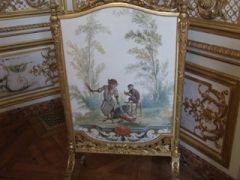
|
Singerie: (sinz'ri)
A motif which depicts the monkey as an means of ornamentation or an element in a mural, fabric, or wallpaper design. Monkeys are often depicted in a humorous light mimicking human behavior and dressed in human attire. The monkey was often combined with chinoiserie in gay, delicate designs. Such murals were used to decorate dadoes and cornices. Singerie originated from French decorator and designer Jean Berain as well as French painter Andieu de Clermont. It was popular in France and England during the 18th century as a result of influence of the "exotic" and "Oriental." In reflection to the trend of Chinese décor singerie depicted during the third decade of the 18th century showcased monkeys attired not in Parisian but in Mandarin dress. |
|
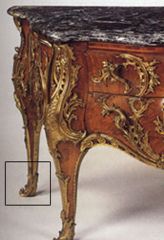
|
Sabot (sa bō)
Metal "shoe," protective as well as ornamental, on the feet of a piece of furniture. Furniture legs during the Rococo period terminated in a sabot. Replacing the Baroque ormolu, the sabot was both decorative as well as functional. Sabots came in many forms, but all following the curved asymmetry of the Rococo period. Often gilded, they “capped” the foot of the furniture leg—giving the appearance of a shoe. |
|
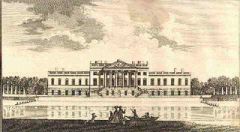
|
Colen Campbell (cōl'en kam'bəl)
(1676-1729) Colen Campbell was a pioneering Scottish architect who spent most of his career in England and is credited as a founder of the English Palladianism. His major published work, Vitruvius Britannicus, or the British Architect... appeared in three volumes between 1715 and 1725. It [Vitruvius Britannicus] is catalogue of design, containing engravings (100 per volume) of English buildings by Inigo Jones and Sir Christopher Wren, as well as Campbell himself and other prominent architects of the era. |
|
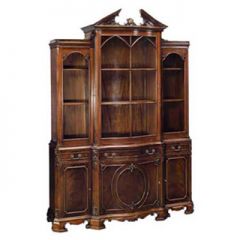
|
Breakfront
A casegood made of three sections in which the middle of the three sections either projects out or is recessed in. During the Georgian period, breakfront furniture was typically made of mahogany. Breakfront casegoods were characteristic of 18th century England. They were introduced in the early part of the century, but became popular in the second half. During the early 1700’s, breakfront furniture was architectural in appearance, but as time went on, classical influences were revealed such as the cornice, arch and pediment. |
|
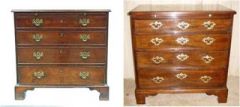
|
Bachelor Chest
A simple chest of drawers, usually 24” to 36” wide by 30” to 36” tall. The wood or veneer varies with the design. Sometimes used in pairs, and sometimes in place of sofa tables. Use began in the Georgian period in England with the rule of King George I in 1714 and continued through 1820. Bachelors used these pieces of furniture in apartments with restricted floor space; their “fold-over” tops were used for writing. This “low chest of drawers” included runners to support the fold-over writing surface and could also have build in corner candle brackets. |
|
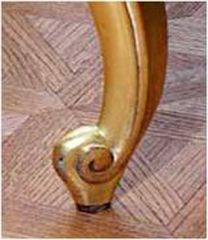
|
Whorl (hwôrl)
Another name for Scroll foot. Carved foot terminating a leg and taking the form of an outward and upward turning scroll. Furniture of the late 17thb century, but achieved popularity in the Louis XV style, when it was used with the cabriole leg. Used on feet of commodes, chests, chairs, tables. |
|

|
Marquise Chair (mäŕ kē)
A completely upholstered small sofa. The Marquis chair is a prototype of a love seat. It has a wide, deep seat and is similar in appearance to the bergere. This French Rococo chair was designed during the Louis XV period and is said to be designed to accommodate the wide skirts and panniers of this time. |
|

|
Nicolas Pineau (pin'yō)
(1684-1754) A French carver, sculptor and decorator. Pineau was employed by the Czar of Russia to carve the cabinet of Peter the Great in the Grand Palais at Peterhof in Rococo detail. Pineau’s work often had representations of plants. Some of the characteristics of Pineau’s work was; asymmetry, delicacy, low relief and verticality. Pineau’s commissions included the hotels of many influential families. He was very in demand by architects of the time to execute interior detail. One of Pineau’s boiserie is installed at the Metropolitan Museum of Art. |
|
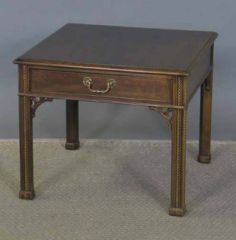
|
Marlborough Leg (märl'bʉr'ō)
A straight leg, sometimes with a molded shape along its length, often ending in a square plinth of slightly greater width. The Marlborough leg was first seen during the Georgian period and replaced the Cabriole leg on many Chippendale furniture pieces. These legs were often fluted or held another simple carved detail. The Marlborough Leg is as definitive of the Chippendale style as the Cabriole leg is for the Queen Anne Style. |
|
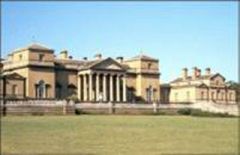
|
William Kent (wilyəm kent)
(1685-1748) 18th century Early Georgian; English architect, interior designer, landscape gardener, and painter, a principal master of the Palladian architectural style, pioneer in the creation of the “informal” English garden, an influences from Inigo Jones and Roman models. It seems that his chief contribution was that he designed furniture to be an ordered part of the architectural scheme of the interior decoration. |
|

|
Genre Pittoresque (zhän'rə (pit'tôr'esk)
(Picturesque Style) Pittoresque is a French term for “picturesque,” referring to conceptual scenes of pleasant character and nostalgic tendencies. Pineau and Meissonier were two designers important in the trend that culminated in the lighthearted compositions of the Louis XI style; with their contemporaries, they originated the style. It is a style of landscape painting and detailing that emphasizes a sentimental aesthetic over the sublime. A style that reassures man of dominion over nature. |
|
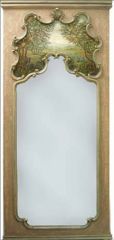
|
Trumeau (trōō'mō)
Decorative panel located above doors, mantels and mirrors serving as ornamentation in wall compositions. Trumeau ornamental panel treatments were popular during the reign of Louis XV and XVI (the Rococo period). The centers of the panels commonly consisted of decorative treatments such as mirrors surmounted by grisaille paintings, fabrics, and tapestries. Original panels were constructed of wood with applied boiserie ornamentation, also carved from wood. Plaster was also used on the panel surface and ornamentation. |
|
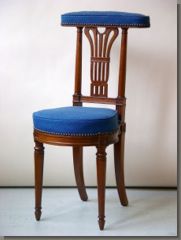
|
Voyeuse (vwa-yōōz)
A chair of the the French Rococo used at game tables, having a padded top rail on which spectators could lean. A person would sit, one leg on each side, facing the back of the chair and rest his elbows on the padded top rail of the voyeuse. It was often used while men played cards around the game table. The seat of this chair is quite high, with the top rail resting upon side supports that are a continuation of the back legs that end in a cushioned piece, that could be termed as a manchette. |
|

|
Jean-Antoine Watteau (zhän än twån wä tō)
(1684-1721) He began his career by copying the works of popular Dutch artists and designing theater sets. Flemish artists Peter Paul Ruben was a major influence. In 1719, Watteau was suffering from tuberculosis so he moved to the country to continue his work. He died in 1721. His work embodied the characteristics of the Rococo period, such as color, line, fantastical nature scenes and aristocratic life. An artist of the French Rococo period whose work was characterized by light, warm colors, free, delicate painting technique, fantastical scenes and attention to detail. He often painted fantastical scenes in which young aristocratic couples met in gardens in amorous pursuits. |
|
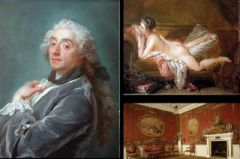
|
Francois Boucher (frän swå' bōō shā)
(1703-1770) A French-born painter, Boucher was a prominent Rococo painter who is associated with the formulation of the mature Rococo style and its dissemination through out Europe. Boucher is known for his idyllic and voluptuous paintings on classical themes. He depicted people being happy and having fun in a non-formal, fantasy way. He painted nudes with pink skin that were in seductive poses, which gave him great success. |
|
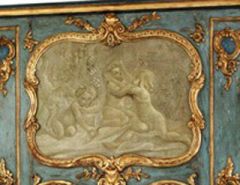
|
Grisaille Painting (grē zā'y)
A painting technique that utilizes various shades of a single tone to create the illusion of depth and sculptural relief. The tone used could be shades of gray or shades of another neutral color, but gray is the most common form. It is also commonly modeled to increase the illusion of relief. Grisaille painting techniques appear in France as early as the 12th century and were used mostly on stained glass windows in churches. Fifteenth century Flemish painters also used this technique. Grisaille was used during the French Regence style but became most popular during the later reign of King Louis XVI. Grisaille painting was used as a separate decorative technique painted on canvas or in conjunction with boiserie paneling, often located in the trumeaux (overdoor or overmantel). Because of its illusion of depth, it was used during the eighteenth century on walls and ceilings to imitate classical architecture and sculpture. |
|
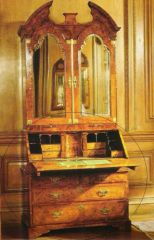
|
Slant-front writing desk
A writing piece that was most often used by women. It is characterized by the slanted, front piece of wood that when folded down, provides writing surface with small drawers and cubbies inside. The lower section had drawers and sat on bracket feet. Often made of walnut veneer and finished with laquer. The important note is that it is the slant front form that is characteristic of this time period, and the naming of the piece, bureau or desk, is differentiated by the presence of the cabinetry on top containing the broken arch pediment that can be opened to reveal drawers and compartments. These pieces were also finished with a japanning technique. |
|
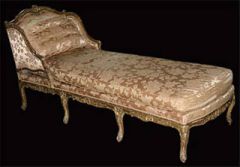
|
Chaise Longue (shāz lônj)
A chaise longue, also known as a “chaise duchesse,” is a chair used for reclining. Its elongated form supports outstretched legs. French for “long chair.” Popular during the French Regence and French Rococo time periods. The chaise longue features some of the rectilinear forms of Louis XIV style, transitioned into the curvilinear forms of Louis XV style. The chaise longue is an elongated chair that often features a rounded back, also known as a “gondola” back. It features six to eight cabriole legs, which are often carved with scroll and shell motifs. It is important to note that the chaise longue is always found as one piece of furniture, contrasted against the “duchesse brisse” which consists of two to three pieces. |
|
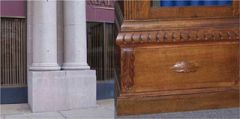
|
Plinth (plinth)
There are two different uses of a plinth. One is seen in architecture, while the other in furniture pieces. The base of a column or piece of furniture can be square, rectangular or octagonal. The base is typically treated with some sort of decoration (molding or relief). A plinth can also be seen in the base of fireplaces and pilasters. |
|

|
Sèvres (sev'rə or se'vr')
A porcelin factory at Sèvres near Paris, founded in 1756. Madame de Pompadour obtained royal patronage for it during the reign of Louis XV. The factory produced magnificent vases and plaques for furniture and table inserts. The term Sèvres is also used to identify the products of the factory, including the vases and urns of a special rose color, as well as King’s blue. Sèvres plaques were sometimes used as a furniture embellishment. From the outset the king's clear aim was to produce Sevres Porcelain that surpassed the established Saxony works of Meissen and Dresden. Though the French lacked an ample supply of kaolin, a required ingredient for hard-paste porcelain (pate dure), their soft-paste porcelain (pate tendre) was fired at a lower temperature and was thus compatible with a wider variety of colors and glazes that in many cases were also richer and more vivid. However, soft-paste Sèvres Porcelain was more easily broken. Therefore, early pieces of Sèvres Porcelain that remain intact are very rare. |
|
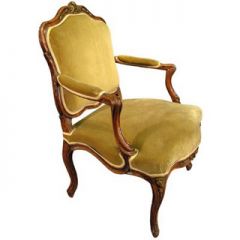
|
Manchette (man'chət)
An upholstered armpad used on furnishings.Manchettes were often found on the armrests of armchairs during the Louis XV era. Furnishings during the reign of King Louis XV focused on providing comfort. So upholstered, curved, wooden armrests provided more comfort for someone sitting in the chair. Manchettes were typically upholstered with needlepoint. |
|
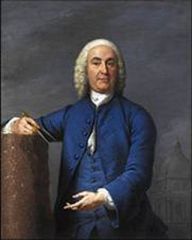
|
James Gibbs
(1682-1754) James Gibbs was an influential Scottish architect and author of the pattern book, Book of Architecture and Rules for Drawing the Several Parts of Architecture. His most well known design is the church of St. Mary-le-Strand in which he was influenced by Christopher Wren and Baroque features. Gibbs practiced in England during the early Georgian Baroque period. Born in Rome, Gibbs studied priesthood, but changed directions to study under Italian Baroque architect, Carlo Fontana. His style incorporated mature Palladian elements as well as forms from Italian Baroque and his works are distinctly characteristic of the Georgian period. Some of his other most influential works include: the church of St Martin in-the-Fields and the circular Radcliffe Camera. Also, the design of the White House in the U.S. was influenced by Gibbs. |
|
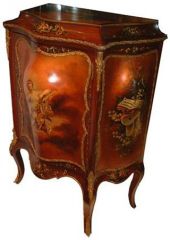
|
Vernis Martin (ver nē mär'tan)
Vernis Martin is a type of lacquer named after the French brothers Guillaume and Etienne-Simon Martin who were successful in improving and eventually perfecting this lacquer technique. Vernis Martin is an imitation Chinese lacquer that was applied to a wide variety of pieces such as furniture, carriages, sedan chairs and snuff boxes. The lacquer is made by heating oil and copal and then adding Venetian turpentine. During the eighteenth century, colored furniture was becoming increasingly popular in France mostly due to the Martin family’s working in painting coaches and varnish or lacquer technique. . |
|

|
Cabriole Leg (kab'rē ōl)
A leg on a piece of furniture which has the shape of two curves, the upper curve is convex and the lower of the two is concave. The influence for the style of this leg came from the appearance of the legs of some four legged animals. This Cabriole style leg was used not only used on chairs, but may also be seen on tables, desks and console tables. There may be carvings seen to decorate the leg, or it is sometimes plain and smooth surface. The cabriole leg was used extensively within the Chipendale time period. |
|
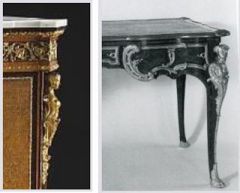
|
Espagnolette (i'span'yə'let)
A sculptural form in the shape of a female bust used as a gently curved ornamental mount on the upright elements of a furniture piece like legs or stiles. Espagnolettes were often bronze and used at the crest of the cabriole leg on bureau plats (writing tables) which were a important furniture item during the French Regence period since people for more educated during this time and spent a lot of time writing correspondence, etc. The use of espagnolettes were very characteristic of the style of Charles Cressent, a sculptor and metal worker who’s furniture is closely identified with the Regence period. |
|
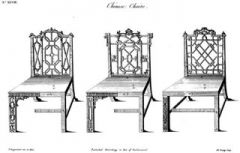
|
Thomas Chippendale
(1718-1779) English cabinetmaker and furniture designer. Published The Gentleman and Cabinet-Maker’s Director. The Gentleman and Cabinet-Maker’s Director was a catalog consisting of 160 plates and notes detailing English furniture design of the time. This publication stands out because it was the largest any designer had ever published and his work detailed the three aspects of the Rococo: French, Gothic, and Chinese. Two revised editions were subsequently published which furthered his influence on furniture of the time. |
|

|
Trumpet Leg
A turned leg that flares upward and outward from a narrow lower end. The trumpet leg is typical of the William and Mary style. The trumpet leg was most often used on chairs legs, but also used in other furniture pieces. Outstanding characteristics of the William and Mary furniture are the turned legs with inverted cups or in a trumpet shape. |
|
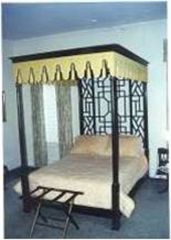
|
Chinese Chippendale Bed
Chinese Chippendale was a period in Chippendale's work, during the mid-18th century. At this point he was greatly influenced by chinoiserie, Chinese motifs and Sir William Chambers. |

